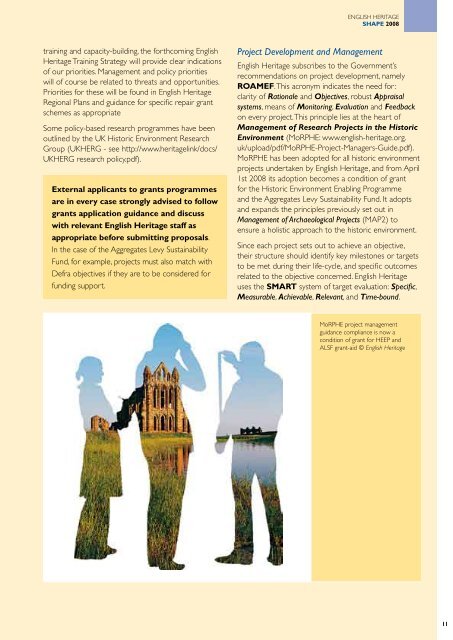shape | pdf - English Heritage
shape | pdf - English Heritage
shape | pdf - English Heritage
Create successful ePaper yourself
Turn your PDF publications into a flip-book with our unique Google optimized e-Paper software.
english heritage<br />
<strong>shape</strong> 2008<br />
training and capacity-building, the forthcoming <strong>English</strong><br />
<strong>Heritage</strong> Training Strategy will provide clear indications<br />
of our priorities. Management and policy priorities<br />
will of course be related to threats and opportunities.<br />
Priorities for these will be found in <strong>English</strong> <strong>Heritage</strong><br />
Regional Plans and guidance for specific repair grant<br />
schemes as appropriate<br />
Some policy-based research programmes have been<br />
outlined by the UK Historic Environment Research<br />
Group (UKHERG - see http://www.heritagelink/docs/<br />
UKHERG research policy.<strong>pdf</strong>).<br />
External applicants to grants programmes<br />
are in every case strongly advised to follow<br />
grants application guidance and discuss<br />
with relevant <strong>English</strong> <strong>Heritage</strong> staff as<br />
appropriate before submitting proposals.<br />
In the case of the Aggregates Levy Sustainability<br />
Fund, for example, projects must also match with<br />
Defra objectives if they are to be considered for<br />
funding support.<br />
Project Development and Management<br />
<strong>English</strong> <strong>Heritage</strong> subscribes to the Government’s<br />
recommendations on project development, namely<br />
ROAMEF. This acronym indicates the need for:<br />
clarity of Rationale and Objectives, robust Appraisal<br />
systems, means of Monitoring, Evaluation and Feedback<br />
on every project. This principle lies at the heart of<br />
Management of Research Projects in the Historic<br />
Environment (MoRPHE: www.english-heritage.org.<br />
uk/upload/<strong>pdf</strong>/MoRPHE-Project-Managers-Guide.<strong>pdf</strong>).<br />
MoRPHE has been adopted for all historic environment<br />
projects undertaken by <strong>English</strong> <strong>Heritage</strong>, and from April<br />
1st 2008 its adoption becomes a condition of grant<br />
for the Historic Environment Enabling Programme<br />
and the Aggregates Levy Sustainability Fund. It adopts<br />
and expands the principles previously set out in<br />
Management of Archaeological Projects (MAP2) to<br />
ensure a holistic approach to the historic environment.<br />
Since each project sets out to achieve an objective,<br />
their structure should identify key milestones or targets<br />
to be met during their life-cycle, and specific outcomes<br />
related to the objective concerned. <strong>English</strong> <strong>Heritage</strong><br />
uses the SMART system of target evaluation: Specific,<br />
Measurable, Achievable, Relevant, and Time-bound.<br />
MoRPHE project management<br />
guidance compliance is now a<br />
condition of grant for HEEP and<br />
ALSF grant-aid © <strong>English</strong> <strong>Heritage</strong><br />
11

















